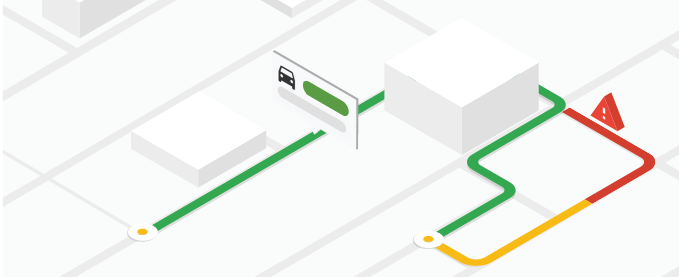
使用 Directions API 的好處
透過 Directions API,您可以取得多種交通方式的路線,例如大眾運輸、開車、步行或騎自行車。
Directions API 的用途
您可以使用 Directions API 計算地點之間的路線,包括下列詳細資料:
- 多種交通方式的路線,包括大眾運輸、開車、步行或騎單車。
- 使用一系列路線控點的多段路線。
- 以多種方式指定起點、目的地和路線控點,包括文字字串 (例如「伊利諾州芝加哥」或「澳洲北領地達爾文」)、地點 ID 或經緯度座標。
Directions API 的運作方式
Directions API 會在計算路線時傳回最有效率的路線。產品會考量下列旅遊元素,判斷最有效率的路線:
- 交通時間 (主要)
- 距離
- 轉彎次數
以下範例要求會以 JSON 格式傳回從安大略省多倫多到魁北克省蒙特婁的行車路線:
https://maps.googleapis.com/maps/api/directions/json ?destination=Montreal &origin=Toronto &key=YOUR_API_KEY
資源
下表列出 Directions API 提供的資源,以及傳回的資料。
| 資料資源 | 傳回的資料 | 傳回格式 |
|---|---|---|
| 路線
以地點 ID、地址或經緯度座標的形式提供起點和終點。詳情請參閱必要參數。 |
詳細路線指示,包括路線、路段和步驟。詳情請參閱「路線指引回應」。 |
|
如何使用 Directions API
| 1 | 做好準備。 | 請先按照「設定 Google Cloud 專案」一文中的操作說明完成設定, |
| 2 | 立即試用 | 取得 API 金鑰和雲端專案後,即可免費試用路線導航範例。請參閱 Directions API 試用版。 |
| 3 | 建構要求 | 請參閱範例要求,並瞭解可提供的選項,例如交通方式、中途點和路線限制。請參閱路線範例。 |
| 4 | 瞭解回覆的基本概念 | 探索資料回應,準備在應用程式中使用路線資料。詳情請參閱「路線回應」。 |
| 5 | 將路線資料整合到自己的應用程式! | 您可以使用這項資料計算旅行距離和時間。 |
可用的用戶端程式庫
透過下列任一用戶端程式庫,以您選擇的語言呼叫這項 API:
Google 地圖服務適用的 Java、Python、Go 和 Node.js 用戶端都是社群支援的用戶端程式庫,並依據阿帕契 2.0 授權的條款提供開放原始碼。您可以從 GitHub 下載這些用戶端,並查看安裝操作說明和程式碼範例。

